A Strength–Permeability Study of Steel Slag–Cement–Bentonite Barrier Walls Effect of Slag Substitution Rate and Bentonite Dosage
Abstract
1. Introduction
2. Materials and Methods
2.1. Test Materials
2.2. Preparation of Samples
2.2.1. Mix Design
2.2.2. Methods of Sample Preparation
2.3. Test Methods
2.3.1. Unconfined Compressive Strength Test
2.3.2. Direct Shear Test
2.3.3. Variable Head Permeability Test
3. Results
3.1. Study on the Unconfined Compressive Strength of Steel Slag–Cement–Bentonite Barrier Materials
3.1.1. Effect of Steel Slag Substitution Rate on the Unconfined Compressive Strength of Barrier Materials
3.1.2. Effect of Bentonite Dosage on the Unconfined Compressive Strength of Barrier Materials
3.2. Study on Shear Strength of Steel Slag–Cement–Bentonite Barrier Material
3.2.1. Effect of Steel Slag Substitution Rate on the Cohesion of Barrier Materials
3.2.2. Effect of Bentonite Dosage on the Cohesion of Barrier Materials
3.3. Study on Permeability of Steel Slag–Cement–Bentonite Barrier Material
3.3.1. Effect of Steel Slag Substitution Rate on the Permeability of Barrier Materials
3.3.2. Effect of Bentonite Dosage on the Permeability of Barrier Materials
4. Discussion
4.1. Effect of Steel Slag Substitution Rate on the Reaction Mechanism and Microstructure of Barrier Materials
4.2. Analysis of the Correlation Between Cohesion and Unconfined Compressive Strength of Barrier Materials
5. Conclusions
- (1)
- The unconfined compressive strength of steel slag–cement–bentonite barrier material decreases gradually with the increase in steel slag substitution rate and has a linear relationship with the steel slag substitution rate; with the increase in bentonite dosage, the strength has an exponential relationship with the bentonite dosage.
- (2)
- Steel slag–cement–bentonite barrier material cohesion with the increase in steel slag substitution rate gradually decreased, and with the steel slag substitution rate is a negative exponential relationship; cohesion with the increase in bentonite dosage and increase, and with the bentonite dosage is a linear relationship.
- (3)
- A higher unconfined compressive strength of the steel slag–cement–bentonite barrier material corresponds to greater cohesion. By establishing the relationship between cohesion and change in unconfined compressive strength, it is found that cohesion and unconfined compressive strength basically satisfy c = (0.23~0.39)qu.
- (4)
- The mechanical properties of steel slag–cement–bentonite barrier materials can be determined by establishing a correlation between cohesion and unconfined compressive strength. When meeting the engineering specifications, the unconfined compressive strength serves as a predictive parameter for estimating shear strength characteristics, enabling systematic evaluation of both strength parameters.
- (5)
- The permeability of steel slag–cement–bentonite barrier materials exhibits an inverse correlation with steel slag substitution rate (0~50%) and bentonite dosage (46~54%). Both parameters collectively dominate the decreasing trend of permeability as their values increase.
Author Contributions
Funding
Institutional Review Board Statement
Informed Consent Statement
Data Availability Statement
Conflicts of Interest
References
- Xue, Q.; Zhan, L.; Hu, L.; Zhan, L.; Li, J. Environmental geotechnics: State-of-the-art of theory, testing and application to practice. China Civ. Eng. J. 2020, 53, 80–94. [Google Scholar]
- Xie, J.; Li, F.S. Overview of the Current Situation on Brownfield Remediation and Redevelopment in China; World Bank: Washington, DC, USA, 2010. [Google Scholar]
- Ma, X. Construction and Improvement of Water Pollution Prevention and Control Mechanism—A Review of the Action Plan for the Prevention and Control of Water Pollution. People’s Yellow River 2021, 43, 165. [Google Scholar]
- Jefferis, S. Cement-bentonite slurry systems. In Proceedings of the International Conference on Grouting and Deep Mixing, New Orleans, LA, USA, 15–18 February 2012; ASCE: Reston, VA, USA, 2012; pp. 1–24. [Google Scholar]
- Opdyke, S.M.; Evans, J.C. Slag-cement bentonite slurry walls. J. Geotech. Geoenvironmental Eng. 2005, 131, 673–681. [Google Scholar] [CrossRef]
- Peng, X.; Liu, C.; Li, S.; Jiang, Y.; Zeng, L. Research on the Setting and Hardening Performance of Alkali-activated Steel Slag-slag Based Cementitious Materials. J. Hunan Univ. (Nat. Sci.) 2015, 42, 47–52. [Google Scholar]
- Zhang, K. Study on Application of Fluidized Waste Soil Backfilling Foundation Pit Side Wall. Master’s Thesis, Jiangsu University of Science and Technology, Zhenjiang, China, 2021. [Google Scholar]
- Wu, Y.; Ben, P.; Wu, L.; Lv, W.; Zhang, G. Overview of domestic and international steel slag treatment and resource utilization technology development status quo. Environ. Eng. 2021, 39, 161–165. [Google Scholar]
- Li, Y. Experimental Analysis of the Influence of Basalt Fiber on Mechanical Properties of Steel Slag Concrete at Low Temperature. Master’s Thesis, Anhui University of Science and Technology, Huainan, China, 2017. [Google Scholar]
- Han, Y. Preparation and performance study of steel slag-based no-burn filter balls. Master’s Thesis, Nanjing Normal University, Nanjing, China, 2021. [Google Scholar]
- Guo, J.L.; Bao, Y.P.; Wang, M. Steel slag in China. Treatment, recycling, and management. Waste Manag. 2018, 78, 318–330. [Google Scholar] [CrossRef] [PubMed]
- Altun, I.A.; Ylmaz, I. Study on steel furnace slags with high MgO as additive in Portland cement. Cem. Concr. Res. 2002, 32, 1247–1249. [Google Scholar] [CrossRef]
- Kourounis, S.; SiVilis, S. Properties and hydration of blended cements with steelmaking slag. Cem. Concr. Res. 2007, 37, 815–822. [Google Scholar] [CrossRef]
- Ding, G.; Jiang, L.; Zhang, J. Influence of Bentonite on Hydrating and Hardening of Cement. J. Wuhan Univ. Technol. 2012, 34, 20–23. [Google Scholar]
- Chen, L.; Hu, F.; Hu, G. Experiment on performance improvement of cement-soil with the dual admixture of fly ash and bentonite in Wuhan area. Explor. Eng. (Rock Soil Drill. Tunneling) 2019, 46, 62–67. [Google Scholar]
- Wang, Z.J.; Zhao, B.M.; Royal, A.C. Investigation of erosion of cement-bentonite via piping. Adv. Mater. Sci. Eng. 2017, 32, 1–8. [Google Scholar] [CrossRef]
- ASTM D 4287; Standard Practice for Classification of Soils for Engineering Purposes (Unified Soil Classification System). ASTM International: West Conshohocken, PA, USA, 2011.
- Mason, B. The Constitution of some basic Open-hearth slags. J. Iron Steel Inst. 1944, 1, 69–80. [Google Scholar]
- Shi, H.; Huang, K.; Wu, K.; Guo, X. Research Advance on Activation and Mechanism of Steel Slag Activity. Fly Ash Compr. Util. 2011, 48–53. [Google Scholar] [CrossRef]
- Zhang, T. Mixture Ratio Test and Model Test Study of Cement-bentonite Mud Cutoff Wall. Master’s Thesis, Hebei University, Baoding, China, 2019. [Google Scholar]
- Huang, L. Laboratory Researches on Mixing Proportion of Cement-Bentonite Slurry Cutoff Wall. Master’s Thesis, Tongji University, Shanghai, China, 2008. [Google Scholar]
- ASTM C617/C617M-15; Standard Practice for Capping Cylindrical Concrete Specimens. ASTM International: West Conshohocken, PE, USA, 2015. [CrossRef]
- GB/T 50123-2019; Geotechnical Test Method Standards. Ministry of Housing and Urban-Rural Development of the People’s Republic of China: Beijing, China; China Planning Press: Beijing, China, 2019.
- Tong, Y. Experimental Study on the Characteristics of Cement-soil Improved by Bentonite. Master’s Thesis, Hefei University of Technology, Anhui, China, 2021. [Google Scholar]
- Wen, M. Study on Controlling Cadmium Pollution of Groundwater by Fly Ash Bentonite Blocking Wall. Master’s Thesis, Chengdu University of Technology, Chengdu, China, 2018. [Google Scholar]
- Yang, J. Experimental study on age effect of slag-cement-bentonite engineering properties. Master’s Thesis, Zhejiang University, Hangzhou, China, 2018. [Google Scholar]

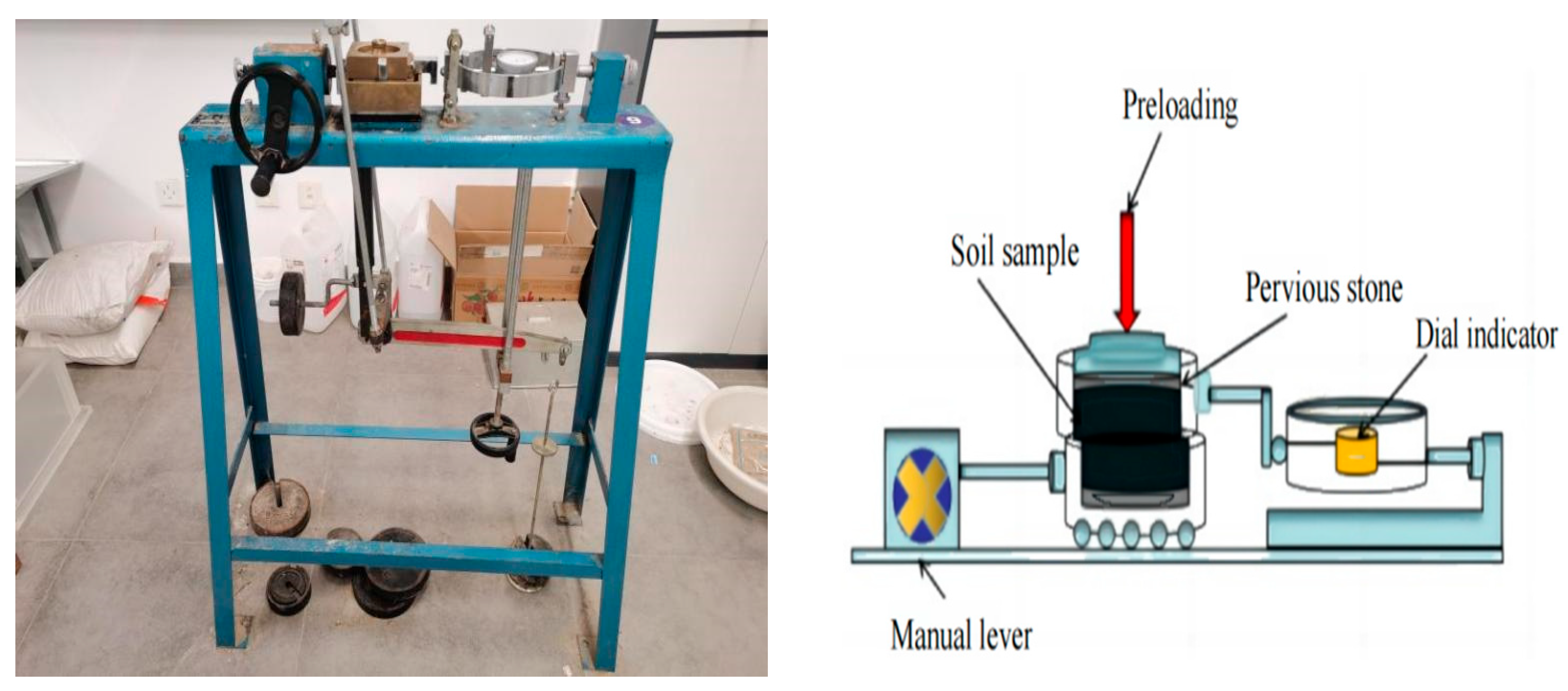
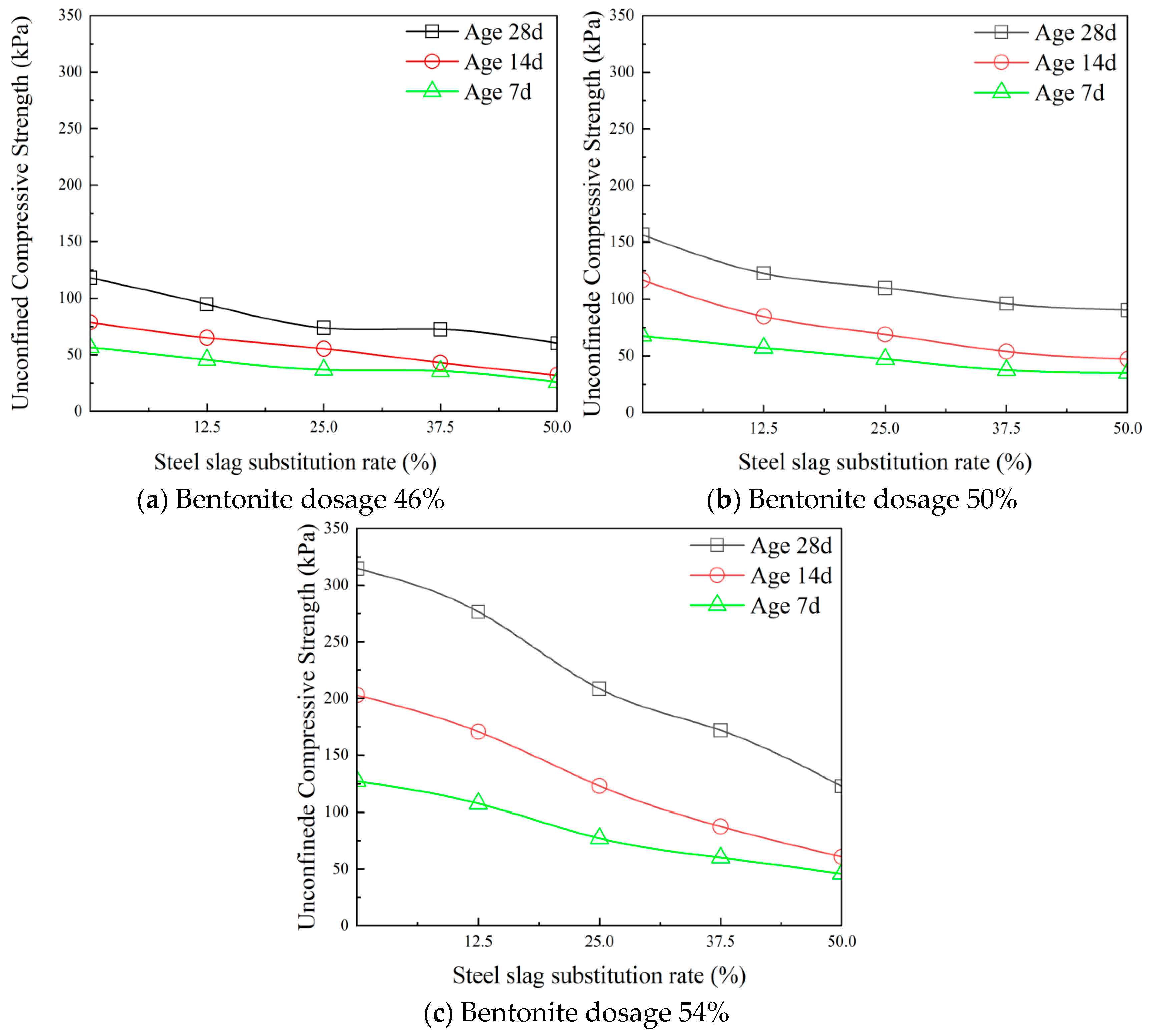

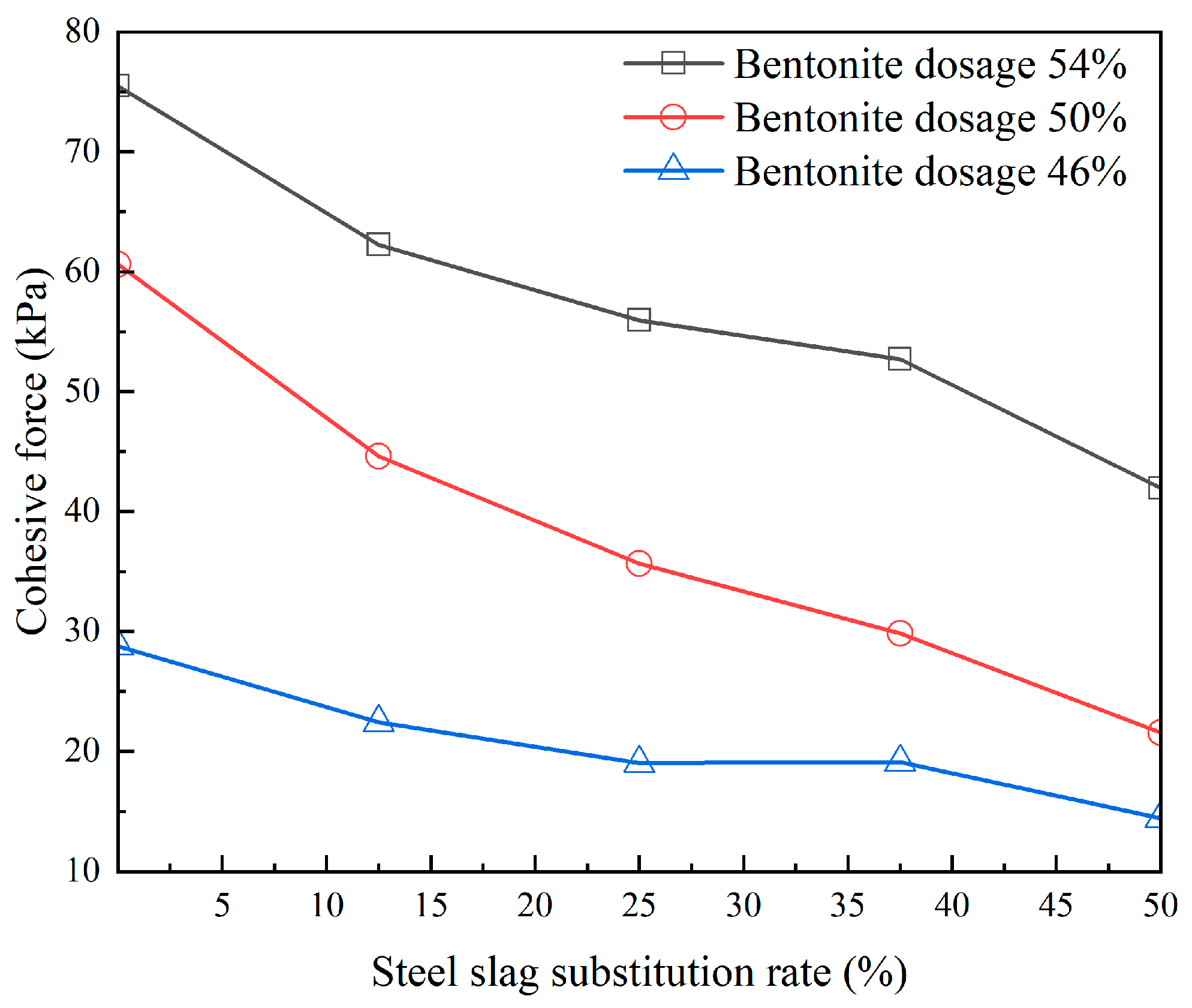
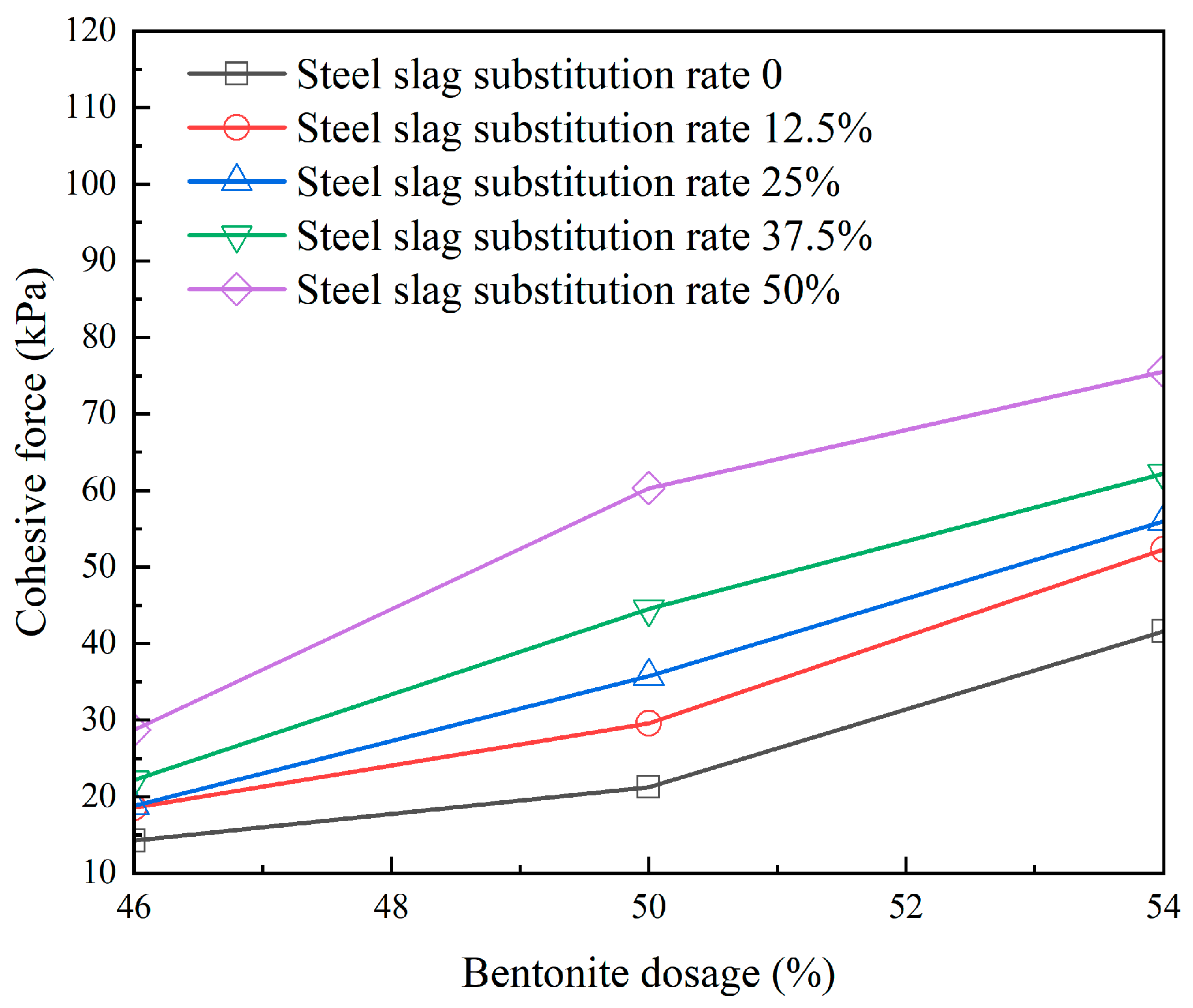

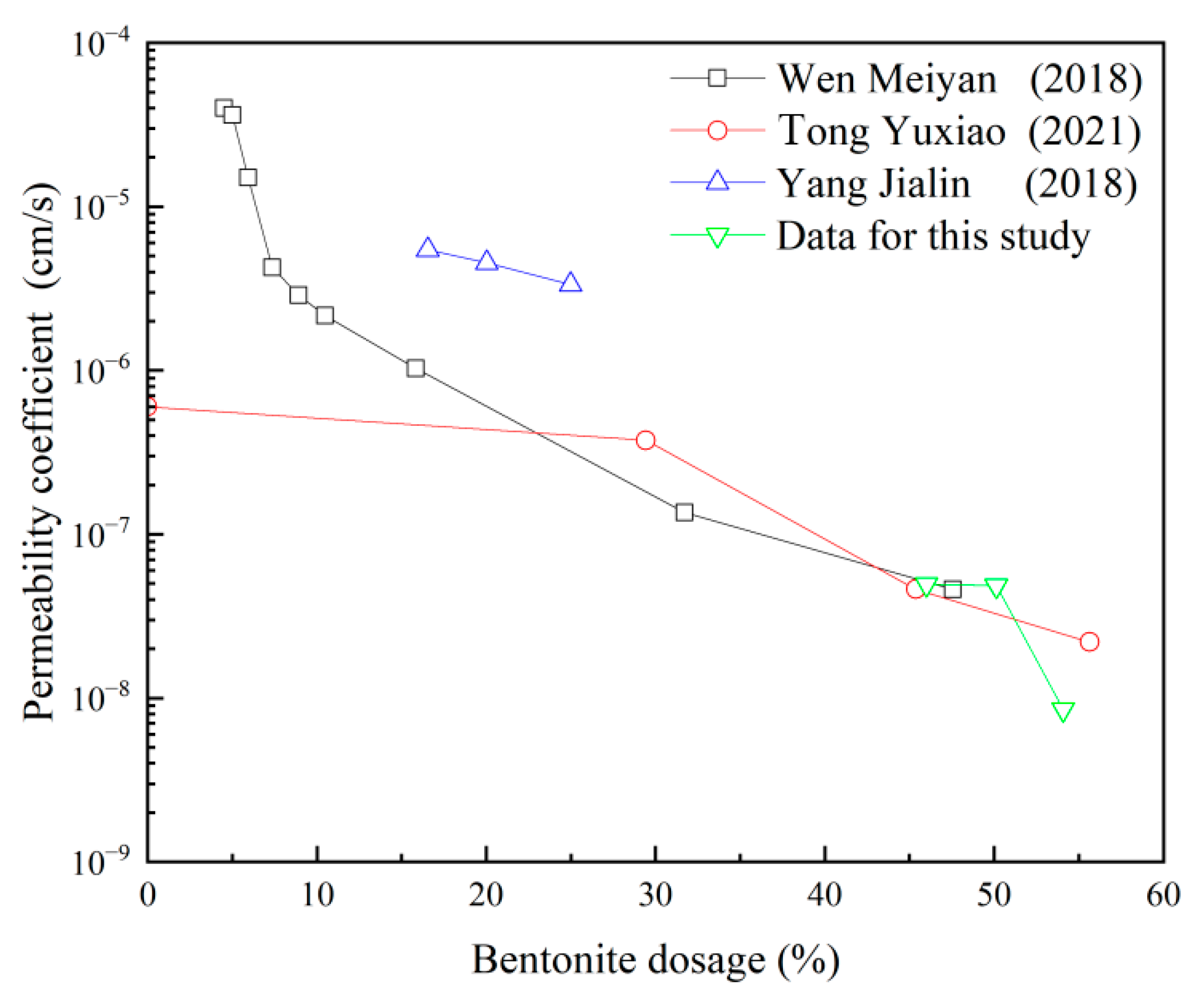

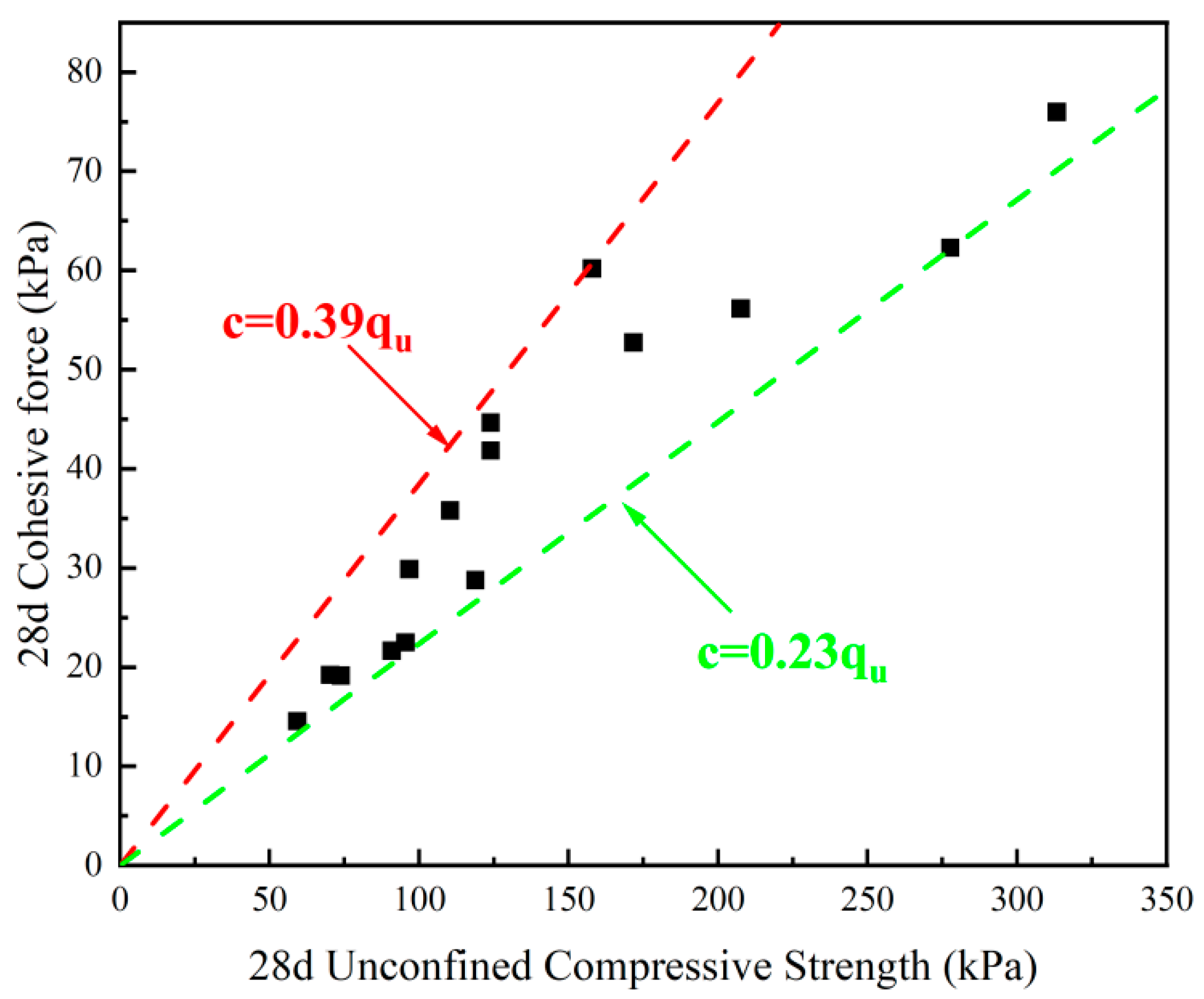
| Chemical Components | SiO2 | Al2O3 | Fe2O3 | CaO | Na2O | MgO | SO3 | K2O | Other Components |
|---|---|---|---|---|---|---|---|---|---|
| Mass percentage (%) | 59.76 | 16.13 | 5.55 | 4.92 | 4.73 | 3.99 | 1.93 | 1.45 | 1.54 |
| Physical Indicator | Measurement Results |
|---|---|
| Loss on filtration (mL) | ≤18 |
| Liquid limit (%) | 169 |
| Plastic limit (%) | 20 |
| Plasticity index | 149 |
| Expansion index (mL/2g) | 24 |
| Chemical Components | CaO | SiO2 | Al2O3 | Fe2O3 | SO3 | MgO | K2O | Other Components |
|---|---|---|---|---|---|---|---|---|
| Mass percentage (%) | 55.03 | 23.07 | 6.66 | 5.31 | 3.84 | 3.33 | 1.01 | 1.75 |
| Testing Items | Stability | 3-Day Flexural Strength (MPa) | 3-Day Compressive Strength (MPa) | Initial Condensation Time (min) | Final Condensation Time (min) | 28-Day Flexural Strength (MPa) | 28-Day Compressive Strength (MPa) | |
|---|---|---|---|---|---|---|---|---|
| National standard | ≥300 | Eligible | ≥3.5 | ≥17 | ≥45 | ≤600 | ≥6.5 | ≥42.5 |
| Measured value | 363 | Eligible | 5.5 | 25.4 | 161 | 234 | 8.4 | 49.8 |
| Ingredient | CaO | Fe2O3 | SiO2 | Al2O3 | MgO | MnO | Cr2O3 | Na2O | P2O5 | TiO2 | SO3 |
|---|---|---|---|---|---|---|---|---|---|---|---|
| Content (%) | 34.30 | 26.22 | 19.64 | 7.72 | 4.14 | 2.49 | 2.08 | 1.06 | 0.76 | 0.52 | 0.49 |
| Olivine slag (geology) | 0.9~1.4 |
| Magnesium Rosette | 1.4~1.6 |
| Dicalcium silicate slag | 1.6~2.4 |
| Tricalcium silicate slag | >2.4 |
| Number | Water (g) | Cement (g) | Steel Slag (g) | Bentonite (g) | Steel Slag Substitution Rate (%) | Bentonite Dosage (%) | Rw/b |
|---|---|---|---|---|---|---|---|
| A1 | 750 | 120 | 0 | 102.2 | 0 | 46 | 6.25 |
| A2 | 750 | 105 | 15 | 102.2 | 12.5 | 46 | 6.25 |
| A3 | 750 | 90 | 30 | 102.2 | 25 | 46 | 6.25 |
| A4 | 750 | 75 | 45 | 102.2 | 37.5 | 46 | 6.25 |
| A5 | 750 | 60 | 60 | 102.2 | 50 | 46 | 6.25 |
| B1 | 750 | 120 | 0 | 120.0 | 0 | 50 | 6.25 |
| B2 | 750 | 105 | 15 | 120.0 | 12.5 | 50 | 6.25 |
| B3 | 750 | 90 | 30 | 120.0 | 25 | 50 | 6.25 |
| B4 | 750 | 75 | 45 | 120.0 | 37.5 | 50 | 6.25 |
| B5 | 750 | 60 | 60 | 120.0 | 50 | 50 | 6.25 |
| C1 | 750 | 120 | 0 | 140.9 | 0 | 54 | 6.25 |
| C2 | 750 | 105 | 15 | 140.9 | 12.5 | 54 | 6.25 |
| C3 | 750 | 90 | 30 | 140.9 | 25 | 54 | 6.25 |
| C4 | 750 | 75 | 45 | 140.9 | 37.5 | 54 | 6.25 |
| C5 | 750 | 60 | 60 | 140.9 | 50 | 54 | 6.25 |
Disclaimer/Publisher’s Note: The statements, opinions and data contained in all publications are solely those of the individual author(s) and contributor(s) and not of MDPI and/or the editor(s). MDPI and/or the editor(s) disclaim responsibility for any injury to people or property resulting from any ideas, methods, instructions or products referred to in the content. |
© 2025 by the authors. Licensee MDPI, Basel, Switzerland. This article is an open access article distributed under the terms and conditions of the Creative Commons Attribution (CC BY) license (https://creativecommons.org/licenses/by/4.0/).
Share and Cite
Li, H.; Xu, H.; Zhang, W.; Gao, L.; Zhou, A. A Strength–Permeability Study of Steel Slag–Cement–Bentonite Barrier Walls Effect of Slag Substitution Rate and Bentonite Dosage. Appl. Sci. 2025, 15, 4544. https://doi.org/10.3390/app15084544
Li H, Xu H, Zhang W, Gao L, Zhou A. A Strength–Permeability Study of Steel Slag–Cement–Bentonite Barrier Walls Effect of Slag Substitution Rate and Bentonite Dosage. Applied Sciences. 2025; 15(8):4544. https://doi.org/10.3390/app15084544
Chicago/Turabian StyleLi, Haoran, Haoqing Xu, Wenyang Zhang, Linhong Gao, and Aizhao Zhou. 2025. "A Strength–Permeability Study of Steel Slag–Cement–Bentonite Barrier Walls Effect of Slag Substitution Rate and Bentonite Dosage" Applied Sciences 15, no. 8: 4544. https://doi.org/10.3390/app15084544
APA StyleLi, H., Xu, H., Zhang, W., Gao, L., & Zhou, A. (2025). A Strength–Permeability Study of Steel Slag–Cement–Bentonite Barrier Walls Effect of Slag Substitution Rate and Bentonite Dosage. Applied Sciences, 15(8), 4544. https://doi.org/10.3390/app15084544






